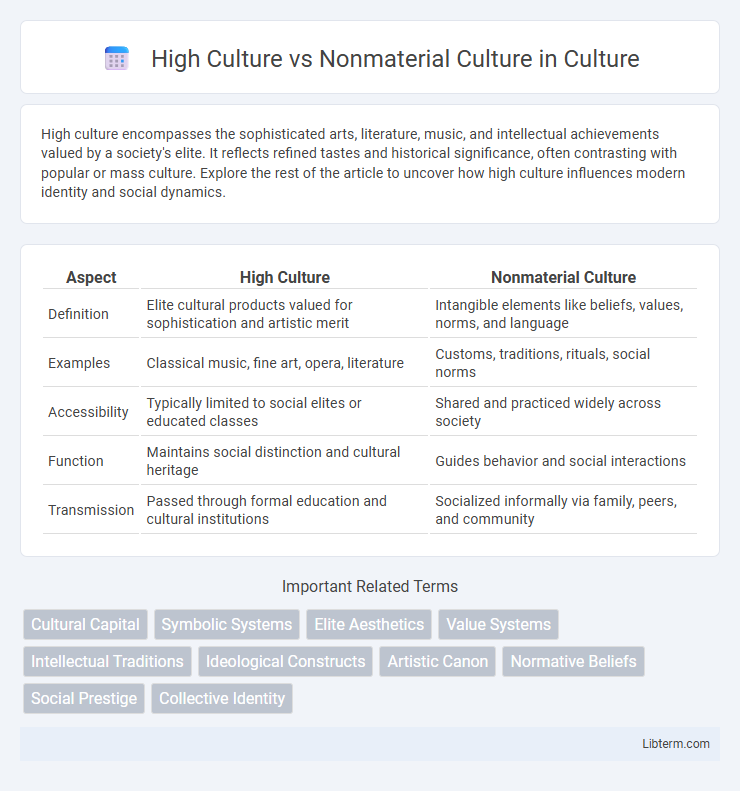High culture encompasses the sophisticated arts, literature, music, and intellectual achievements valued by a society's elite. It reflects refined tastes and historical significance, often contrasting with popular or mass culture. Explore the rest of the article to uncover how high culture influences modern identity and social dynamics.
Table of Comparison
| Aspect | High Culture | Nonmaterial Culture |
|---|---|---|
| Definition | Elite cultural products valued for sophistication and artistic merit | Intangible elements like beliefs, values, norms, and language |
| Examples | Classical music, fine art, opera, literature | Customs, traditions, rituals, social norms |
| Accessibility | Typically limited to social elites or educated classes | Shared and practiced widely across society |
| Function | Maintains social distinction and cultural heritage | Guides behavior and social interactions |
| Transmission | Passed through formal education and cultural institutions | Socialized informally via family, peers, and community |
Understanding High Culture: Definition and Significance
High culture encompasses the sophisticated cultural products and practices associated with elite social classes, such as classical music, fine arts, literature, and philosophy. It reflects society's intellectual and artistic achievements, often serving as a benchmark for cultural refinement and education. Understanding high culture is significant for analyzing social stratification, cultural capital, and the preservation of heritage within societies.
What Is Nonmaterial Culture? An Overview
Nonmaterial culture refers to the intangible aspects of a society that shape individuals' behaviors, beliefs, and values, including language, norms, customs, and rituals. It contrasts with high culture, which encompasses elite artistic expressions such as classical music, fine art, and literature, valued for their aesthetic and intellectual significance. Understanding nonmaterial culture is essential for analyzing how societies transmit knowledge, maintain social order, and create shared meanings without relying on physical artifacts.
Origins and Evolution of High Culture
High culture originated in ancient civilizations, reflecting the artistic, intellectual, and social achievements of elites through literature, classical music, philosophy, and fine arts. Its evolution was shaped by historical events, including the Renaissance and Enlightenment, which emphasized human creativity and knowledge. Nonmaterial culture, encompassing beliefs, values, and customs, intersects with high culture by influencing societal norms and collective identity over time.
Components of Nonmaterial Culture
Nonmaterial culture consists of intangible elements such as beliefs, values, norms, language, rituals, and symbols that shape human behavior and social interaction. These components influence how individuals interpret their world and communicate within society, reinforcing shared meanings and cultural identity. Understanding nonmaterial culture is essential for analyzing the underlying frameworks that guide group dynamics beyond tangible artifacts and high culture expressions like art and literature.
High Culture and Social Stratification
High culture encompasses the refined practices, arts, literature, and philosophies associated with the elite or upper class, often serving as a marker of social stratification. This cultural domain includes classical music, fine arts, and intellectual pursuits that distinguish higher social strata from other groups. The consumption and appreciation of high culture often reinforce social hierarchies by symbolizing education, wealth, and access to exclusive social networks.
The Role of Values, Beliefs, and Norms in Nonmaterial Culture
Values, beliefs, and norms form the foundation of nonmaterial culture by guiding behavior and shaping social expectations within a society. Nonmaterial culture encompasses the intangible elements such as ethics, customs, and ideologies that influence high culture practices, including art, literature, and philosophy. These shared values and norms reinforce social cohesion and provide a framework for interpreting symbolic meanings in both everyday life and elite cultural expressions.
Key Differences Between High Culture and Nonmaterial Culture
High culture encompasses the sophisticated arts, literature, and intellectual achievements valued by a society's elite, while nonmaterial culture consists of intangible elements like beliefs, customs, values, and norms shared by a community. High culture often represents exclusive cultural products associated with prestige, whereas nonmaterial culture reflects the collective social practices that guide everyday behavior. The primary difference lies in high culture's emphasis on tangible cultural artifacts and artistic expressions versus nonmaterial culture's focus on abstract social constructs and meanings.
How High Culture Influences Society
High culture, encompassing classical music, fine arts, and literature, shapes societal values by promoting intellectual engagement and aesthetic appreciation. This influence fosters social cohesion and identity through shared cultural experiences and traditions among elite groups. Consequently, high culture often guides educational priorities and informs public policies on arts and cultural preservation.
The Impact of Nonmaterial Culture on Everyday Life
Nonmaterial culture, comprising beliefs, values, norms, and language, profoundly shapes everyday interactions and social behaviors by guiding individuals' perceptions and decision-making processes. Unlike high culture, which is often associated with elite artistic and intellectual expressions, nonmaterial culture influences routine activities such as communication patterns, customs, and moral judgments across all social strata. This pervasive impact underscores how deeply embedded nonmaterial cultural elements are in shaping identity, social cohesion, and community dynamics in daily life.
Bridging the Gap: Interactions Between High Culture and Nonmaterial Culture
High culture, often characterized by classical music, fine arts, and literature, intersects with nonmaterial culture through shared beliefs, values, and traditions that influence societal norms and identity. The interaction between these cultural forms fosters a dynamic exchange where high culture adapts accessible symbols and practices from everyday life, while nonmaterial culture gains enrichment from the prestige and sophistication associated with elite artistic expressions. This bridging enhances cultural cohesion and promotes a deeper understanding of both elite and popular cultural experiences within society.
High Culture Infographic

 libterm.com
libterm.com